Overview
Power BI datamarts are self-service data warehouses designed to simplify data management and analysis for business users, enabling them to prepare and analyze data from various sources without extensive technical skills. The article supports this by highlighting key benefits such as improved information accessibility, enhanced collaboration, and robust analytics capabilities, which collectively empower organizations to make informed decisions and optimize operational efficiency.
Introduction
In the fast-paced landscape of modern business, organizations are increasingly recognizing the need for robust data management solutions that empower users to make informed decisions. Power BI Datamarts emerge as a pivotal tool in this transformation, offering a self-service data warehouse that simplifies the complexities of data preparation and analysis. By integrating seamlessly with existing data sources and leveraging advanced automation tools like Robotic Process Automation (RPA), businesses can enhance operational efficiency and drive strategic growth.
As industries transition towards data-driven models, understanding how to effectively implement and maximize the benefits of Power BI Datamarts becomes essential for maintaining a competitive edge. This article delves into the definition, benefits, integration capabilities, best practices, and real-world applications of Power BI Datamarts, providing valuable insights for organizations eager to harness the power of their data.
Understanding Power BI Datamarts: Definition and Purpose
Power BI datamarts represent a revolutionary aspect aimed at simplifying information management and analysis for business users. Acting as a self-service data warehouse, Power BI datamarts empower users to efficiently prepare, manage, and analyze data from diverse sources, all without the need for extensive technical skills. This integration allows users to craft insightful reports and dashboards based on a centralized and curated dataset, significantly enhancing operational efficiency through Power BI datamarts.
In a rapidly evolving AI landscape, leveraging Robotic Process Automation (RPA) tools like EMMA RPA and Microsoft Power Automate can further automate manual workflows, reducing the time spent on repetitive tasks and enabling teams to focus on strategic initiatives. These RPA solutions tackle significant challenges like task repetition fatigue and staffing shortages, making them vital for entities aiming to optimize their operations. As industries transition towards digital-first business models, the ability to harness such tools is crucial.
The World Economic Forum forecasts that by 2025, 50% of employees will need substantial reskilling, emphasizing the importance for companies to invest in user-friendly data solutions. Kira Belova notes that ‘the BI landscape is set for rapid evolution and expansion, which offers immense potential for organizations to harness data-driven insights for strategic decision-making.’ By merging BI data hubs with RPA solutions, companies can manage this transition more efficiently, enabling informed decision-making and strategic planning, ultimately fostering growth and innovation in an increasingly data-driven landscape.
Moreover, the manufacturing sector’s digital transformation, valued at $263 billion in 2020 and expected to reach $767 billion by 2026, highlights the financial consequences of adopting advanced information management tools. This case study demonstrates that 86% of manufacturing companies indicate that one hour of system downtime can result in a loss of at least $300,000, emphasizing the importance of tools such as BI analytics and RPA. As the adoption of these technologies continues to increase, entities are better positioned to utilize information for competitive advantage, ensuring they remain resilient and proactive in response to changing market demands.
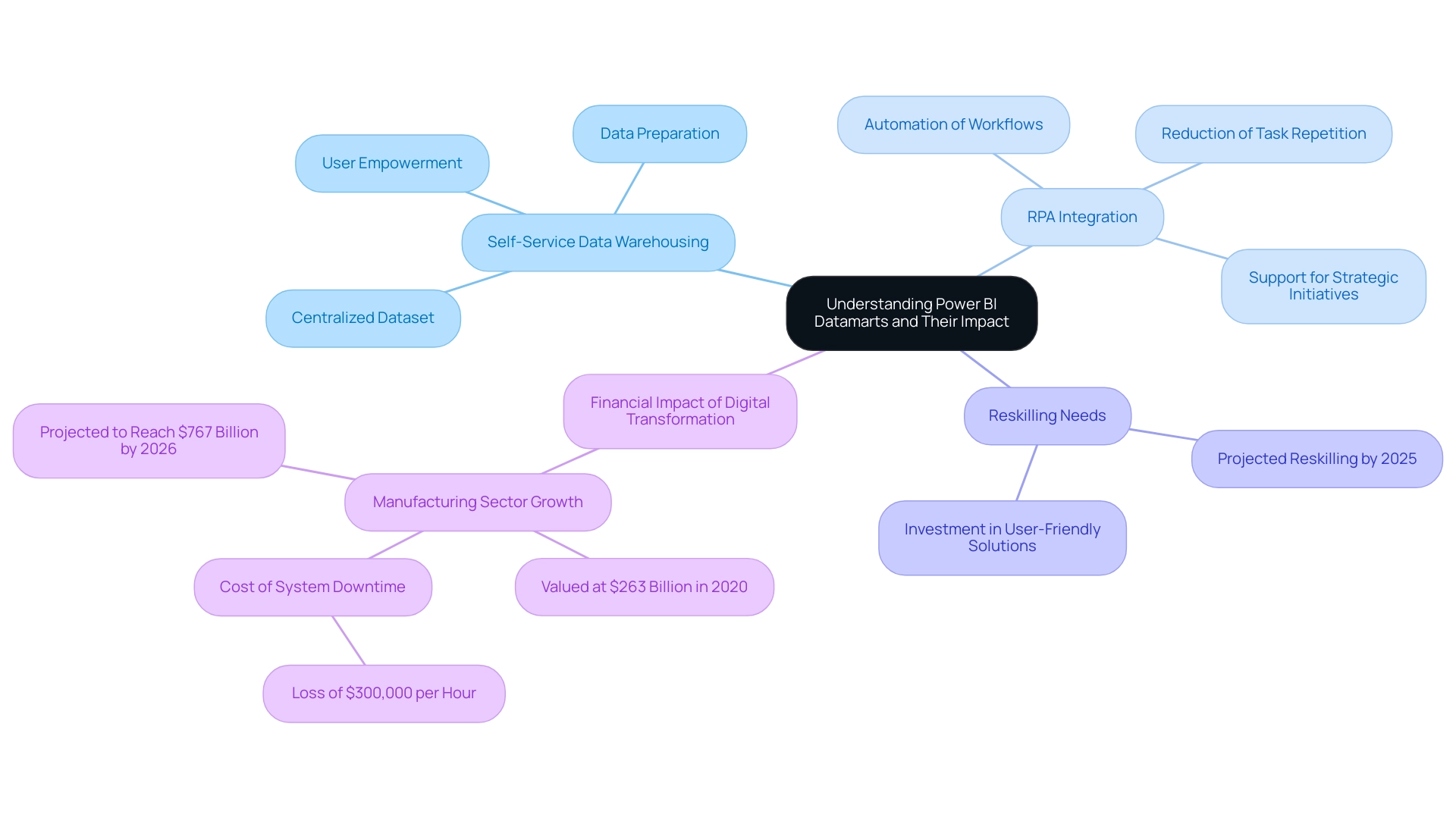
Key Benefits of Power BI Datamarts for Data Management
These analytical tools provide numerous advantages, rendering them an attractive option for organizations keen on enhancing their information management strategies, particularly regarding operational efficiency. Notable advantages include:
-
Simplified Data Preparation: Power BI data hubs enable users to seamlessly connect to various sources of information, transform content, and create a cohesive analytical view without requiring intricate coding or extensive IT assistance.
-
Improved Information Accessibility: By centralizing information in an intuitive platform, business users gain the ability to independently access and analyze details, thereby reducing reliance on IT departments and expediting decision-making processes.
-
Enhanced Cooperation: These information repositories promote teamwork by providing a common source available to various users, ensuring that all individuals function from the same collection of knowledge. Encouraging open communication and empathy can further enhance collaboration and cohesion within teams.
-
Robust Analytics Capabilities: Featuring building information modeling and reporting tools, Power BI Datamarts enable users to swiftly generate insights, allowing organizations to adapt effectively to evolving business conditions. This is especially pertinent considering that a recent case study showed a mid-sized healthcare company encountered considerable challenges, including manual information entry errors and slow testing processes, which resulted in the implementation of GUI automation. Through this automation, the company reduced entry errors by 70% and improved workflow efficiency by 80%.
-
Cost-Effectiveness: By optimizing information management workflows and reducing the necessity for extensive IT participation, BI solutions can lead to significant cost reductions for entities, enabling more efficient resource distribution.
Furthermore, to address resistance to novel concepts, entities should actively listen and foster alliances among stakeholders. This method can greatly improve the acceptance of BI Databases, ensuring that all team members are aligned with the transition.
In summary, Power BI Datamarts not only streamline information management but also enable enterprises to utilize their information’s full potential for strategic benefit. As companies navigate the challenges of 2024, investing in such innovative solutions aligns with the growing preference for self-service forums, where 67% of customers seek peer-driven insights to enhance their operational efficiency. Moreover, combining Robotic Process Automation (RPA) with Business Intelligence data stores can further simplify manual workflows, improving overall productivity and operational effectiveness.
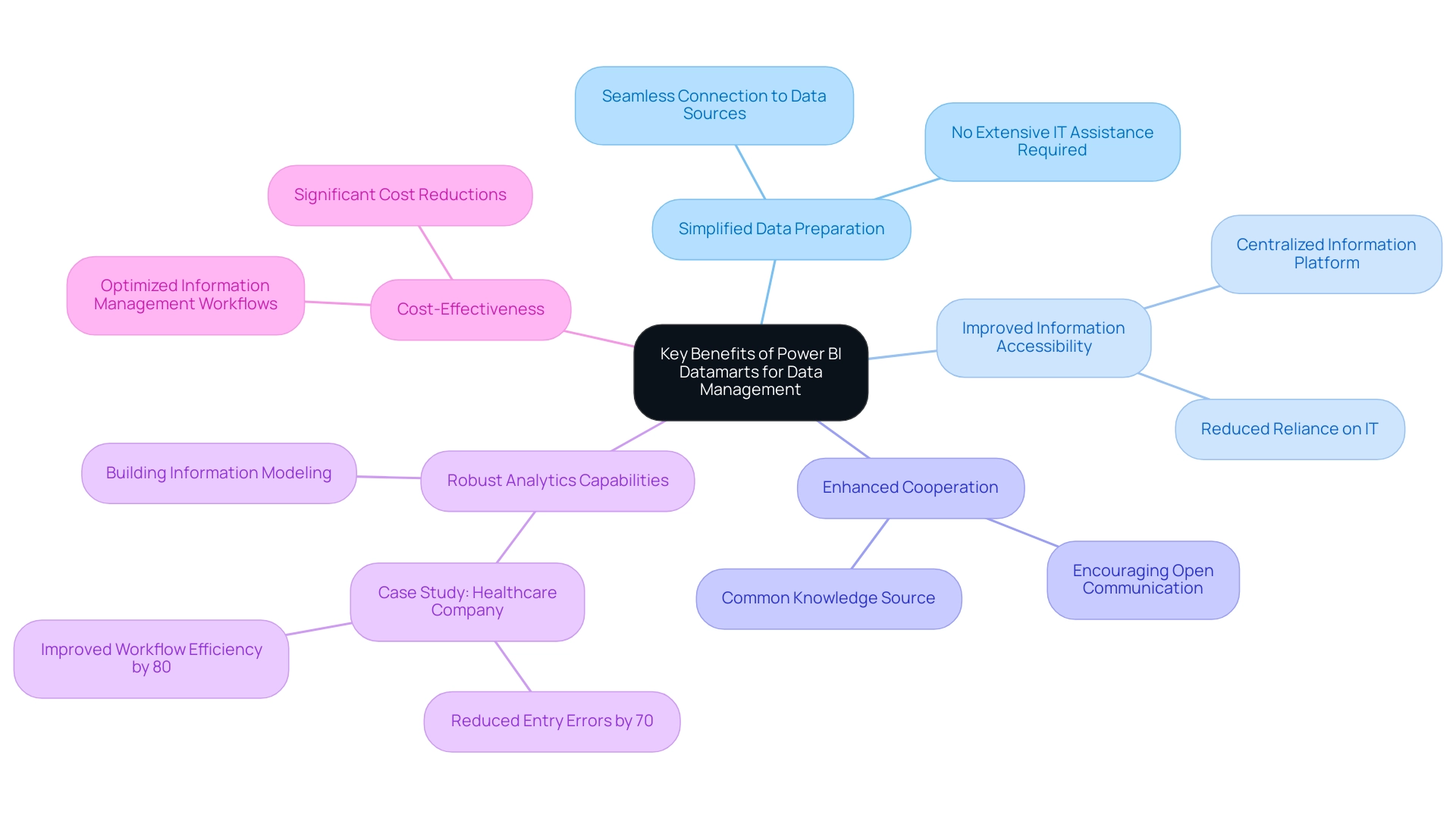
How Power BI Datamarts Integrate with Existing Data Sources
Power BI data warehouses provide exceptional flexibility by effortlessly linking to a broad range of information sources, improving functionality and allowing entities to optimize their current resources. This capability is crucial in today’s environment where leveraging Robotic Process Automation (RPA) to automate manual workflows is essential for boosting operational efficiency. However, manual workflows often lead to inefficiencies, errors, and wasted resources, underscoring the need for automation.
The following integration points highlight this capability:
-
Cloud Services: Data repositories can effortlessly link to cloud-based databases such as Azure SQL Database, Amazon Redshift, and Google BigQuery. This connectivity enables entities to harness the full potential of their cloud information investments, facilitating scalability and accessibility.
-
On-Premises Databases: Organizations have the option to connect data repositories to on-premises sources, including SQL Server, Oracle, and other relational databases. This hybrid approach empowers organizations to blend traditional and contemporary strategies effectively.
-
Power BI Datamarts can access information through APIs and web services, which enables real-time integration from various applications. This feature guarantees that decision-makers have access to the most current information for informed decision-making.
-
Excel and CSV Files: Users can import information directly from Excel spreadsheets and CSV files, offering flexibility in input and streamlining workflows.
By enabling these vital links, Power BI solutions empower entities to create a comprehensive information ecosystem that supports effective analysis and reporting. In a rapidly evolving AI landscape, the demand for efficient information management solutions like Power BI Datamarts is evident, especially as the social business intelligence market is projected to be worth $25,886.8 million in 2024. As Kira Belova emphasizes, “The BI landscape is set for rapid evolution and expansion, offering immense potential for organizations to harness data-driven insights for strategic decision-making.”
This evolution highlights the significance of integrating strong information sources and utilizing RPA to enhance operational efficiency. For instance, a case study by Inkwood Research demonstrated how a leading retail company optimized its business intelligence systems through effective data integration and RPA, resulting in a 30% reduction in manual data entry errors and significant time savings. Furthermore, tailored AI solutions can further streamline these processes, ensuring that entities navigate the complexities of the AI landscape effectively.
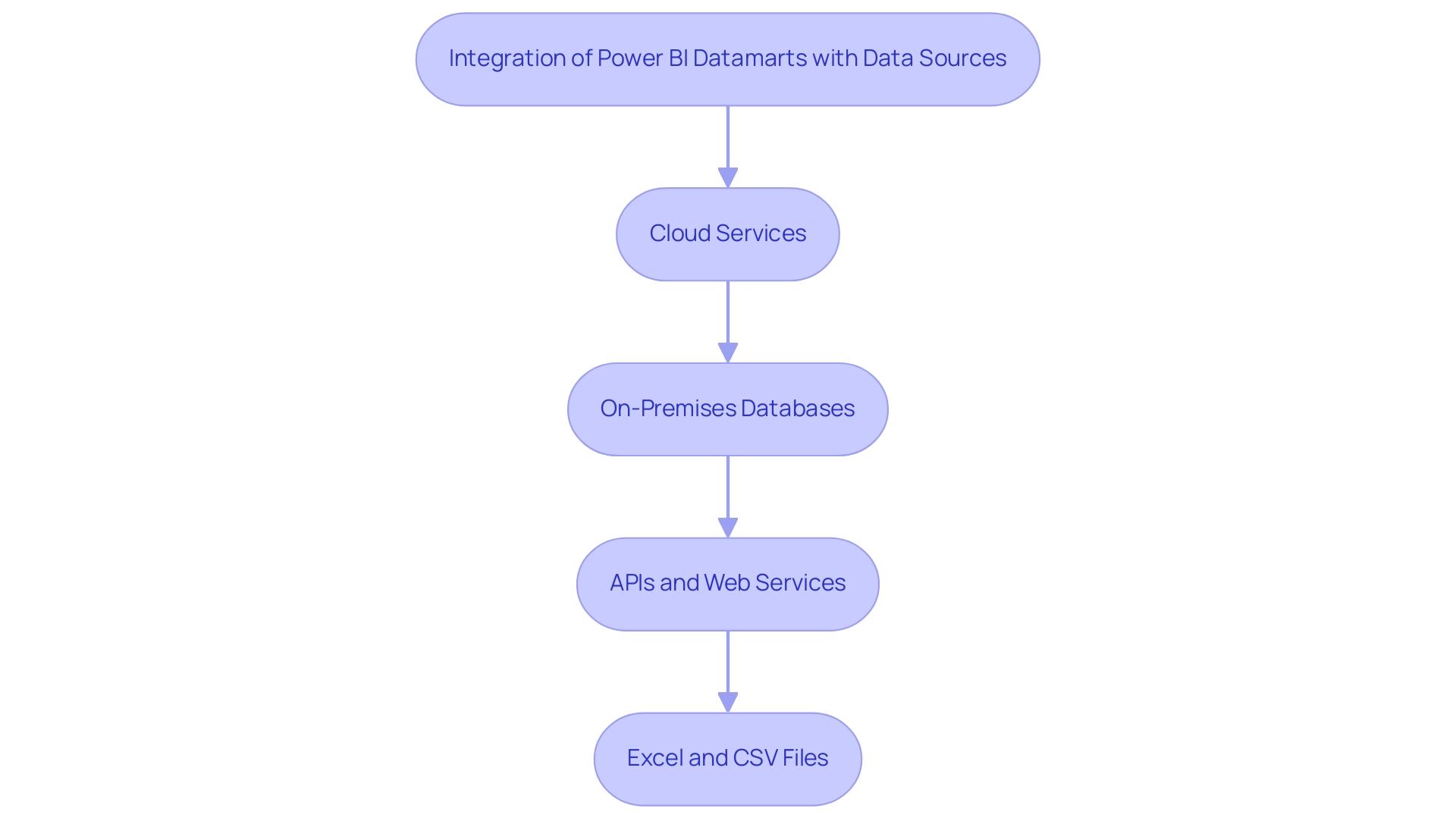
Best Practices for Implementing Power BI Datamarts
To effectively implement BI Datamarts, organizations should adhere to the following best practices:
-
Define Clear Objectives: Establishing precise goals is essential before implementation. Organizations must ensure that the setup of powerbi datamarts aligns with their strategic business objectives, enhancing clarity and direction. Leveraging insights from our 3-Day Business Intelligence Sprint can help in refining these objectives, allowing teams to focus on actionable outcomes that drive efficiency. This Sprint not only promises a fully functional report on a chosen topic but also provides a template for future projects, ensuring consistency in design and functionality.
-
Involve Stakeholders Early: Engaging key stakeholders from various departments at the onset can significantly enhance the identification of information requirements. This collaborative approach guarantees that the powerbi datamarts will cater to the needs of all users, fostering a sense of ownership and accountability, much like the tailored solutions provided by Creatum’s comprehensive services.
-
Maintain Quality: Implementing rigorous cleansing and validation processes is paramount to ensuring the accuracy and reliability of the information in the Database. High information quality is crucial for effective decision-making. Continuous improvement in this area is essential, as emphasized by the importance of data quality in analytics journeys discovered through our training workshops.
-
Regularly Monitor and Update: Organizations should develop robust monitoring systems to assess the performance and usage of their data repositories. By making timely adjustments based on these insights, they can enhance efficiency and user satisfaction. The integration of Robotic Process Automation (RPA) can streamline these processes, significantly improving operational efficiency and enabling teams to focus on strategic tasks.
-
Provide Training and Support: Offering comprehensive training sessions and continuous support for users is vital to boost adoption rates. Equipping teams with the necessary skills ensures they can utilize the data repositories effectively. The user-friendly design of our BI tools, supported by tailored training solutions, enhances operational efficiency and empowers teams to make informed decisions. Our training workshops are particularly crafted to support this learning journey, guaranteeing that users are well-equipped to use the tools available to them.
By adopting these optimal practices and leveraging the resources from our 3-Day BI Sprint, organizations can establish a robust framework that enhances the application of powerbi datamarts, ultimately improving their information management skills and promoting informed decision-making.
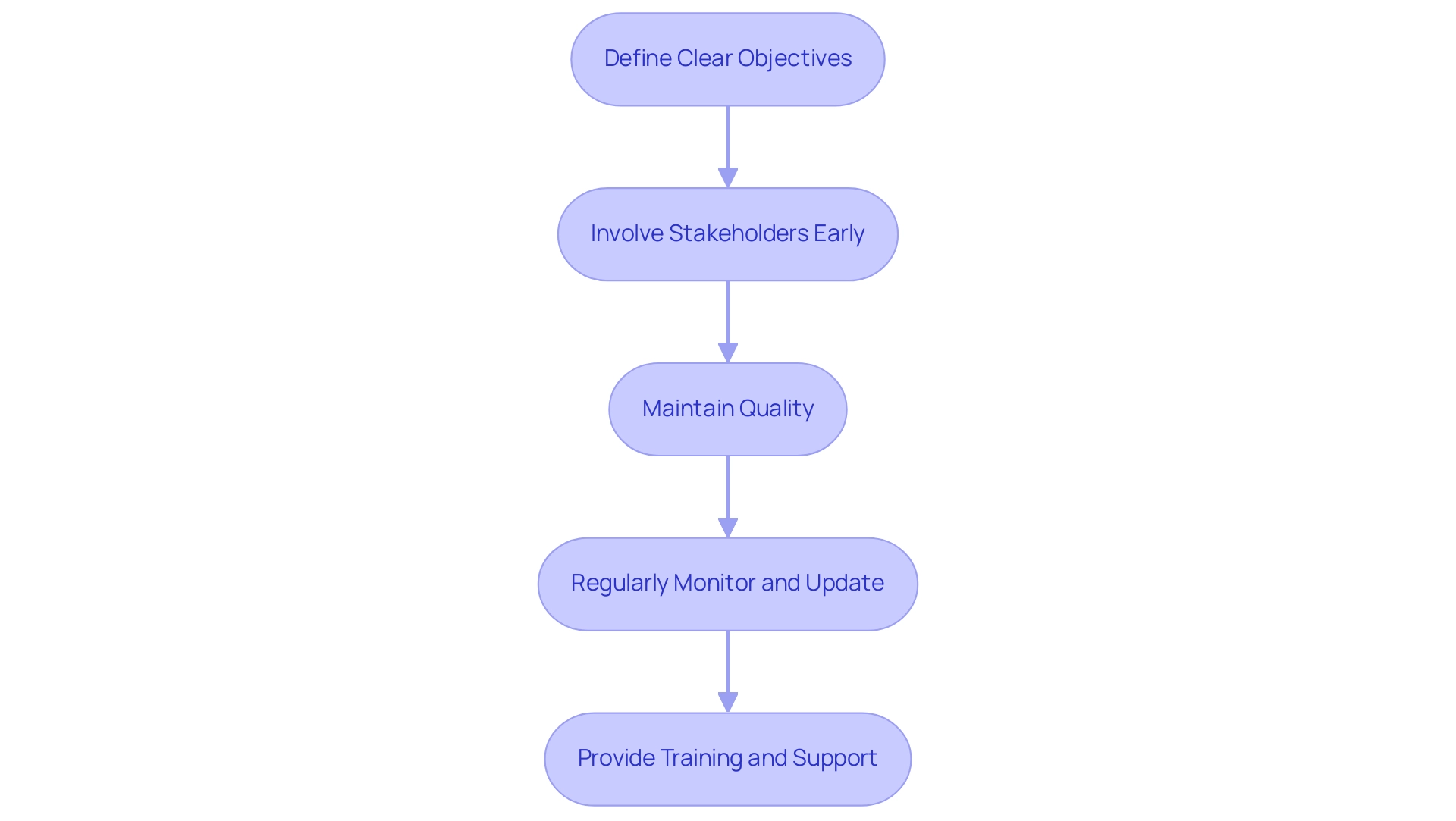
Real-World Use Cases of Power BI Datamarts
Powerbi datamarts have demonstrated to be invaluable resources across various sectors within Business Intelligence, showcasing their flexibility and efficiency in improving operational results. This project aims to optimize the visualization and analysis of information related to exporting and importing agricultural products in Mexico, which is critical for informed decision-making.
-
Retail Analytics: A leading retail firm utilized the capabilities of Power BI to consolidate sales information from multiple sources.
This integration allowed them to delve into customer behavior patterns and refine inventory management strategies. Consequently, they accomplished an impressive 15% rise in sales, mainly due to focused marketing efforts guided by insights. -
Healthcare Reporting: In the healthcare sector, a leading provider adopted data warehouses to amalgamate patient information from multiple departments.
This initiative not only improved reporting accuracy but also ensured compliance with regulatory standards. The improved accessibility of information resulted in better patient care and increased operational efficiency.
A financial institution effectively utilized powerbi datamarts to create a centralized repository for transaction information.
This setup facilitated real-time fraud detection and comprehensive risk assessments. By proactively managing information, the institution significantly mitigated financial losses, demonstrating the critical role of analytics in safeguarding assets.
Policymakers can also leverage the dashboard to visualize and compare export trends across states, allowing for more informed decisions regarding trade policies, subsidies, and specific agricultural development sectors. However, it is important to note that the current dashboard has limitations in granularity and lacks predictive analytics capabilities. The challenges of time-consuming report creation and inconsistencies can hinder effective decision-making.
To truly harness the power of Business Intelligence and RPA for operational excellence, future developments should focus on enhancing information granularity, integrating predictive capabilities, and expanding metrics beyond currency values. Additionally, tailored AI solutions can help businesses navigate the overwhelming AI landscape, ensuring they leverage the full potential of their data.
These illustrative examples underscore the transformative potential of powerbi datamarts, which empower organizations to leverage data-driven insights for informed decision-making and operational efficiency amidst the complexities of modern business environments.
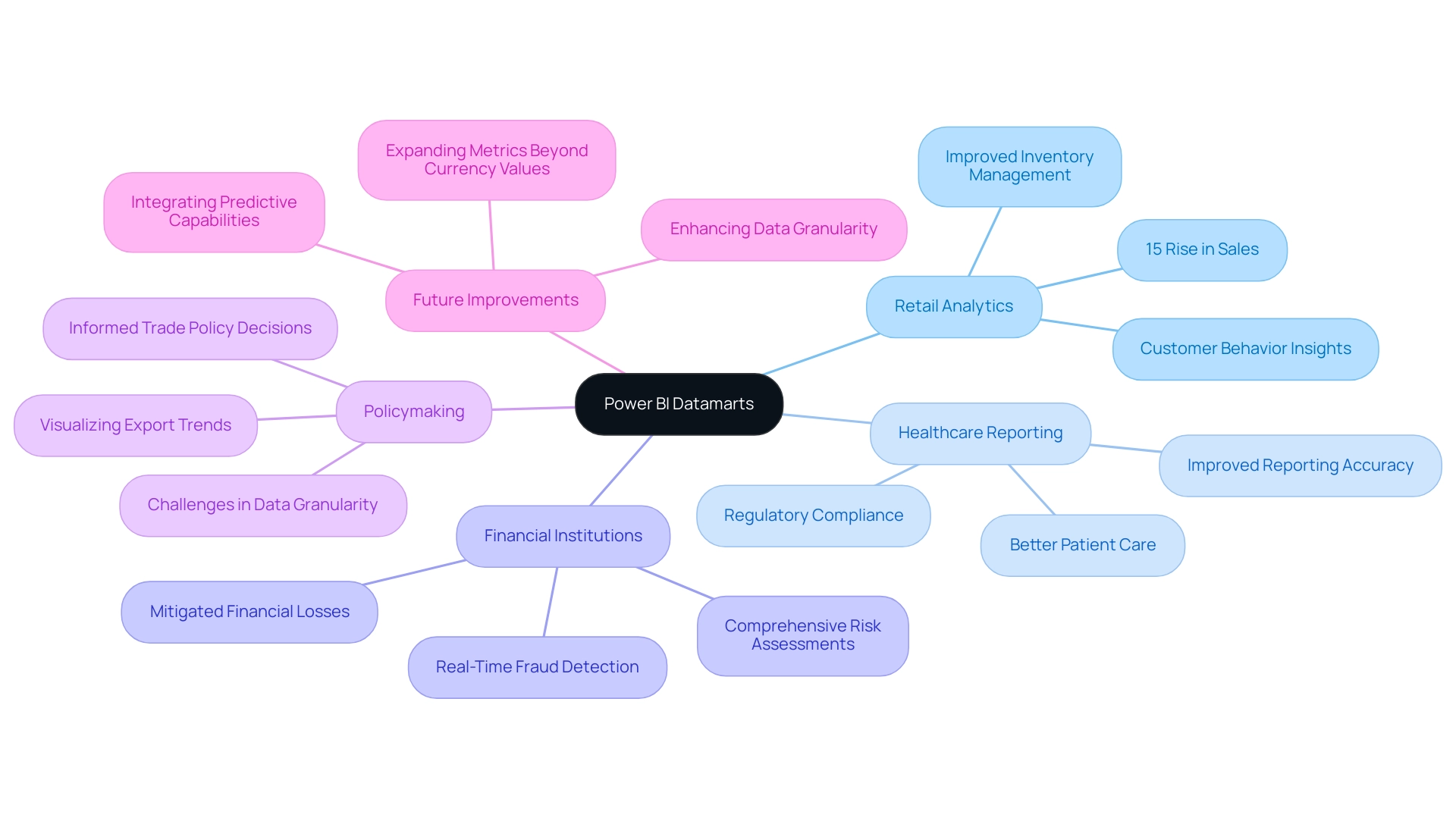
Conclusion
Power BI Datamarts represent a groundbreaking advancement in data management, empowering organizations to harness their data’s full potential. By simplifying data preparation, enhancing accessibility, and promoting collaboration, these tools allow business users to create insightful reports and dashboards without the need for extensive technical expertise. The integration of Robotic Process Automation (RPA) further amplifies these benefits, automating repetitive tasks and freeing up valuable resources for strategic initiatives.
Implementing Power BI Datamarts not only streamlines data management but also supports organizations in navigating the complexities of a data-driven landscape. By adhering to best practices such as:
– Defining clear objectives
– Involving stakeholders
– Maintaining data quality
Businesses can maximize the effectiveness of their Datamarts. Real-world applications across various industries—from retail to healthcare—illustrate how these tools drive operational efficiency, improve decision-making, and ultimately contribute to strategic growth.
As industries continue to evolve, the necessity for robust data management solutions becomes increasingly clear. The adoption of Power BI Datamarts, coupled with RPA, positions organizations to thrive in an ever-changing environment. By embracing these innovative solutions, businesses can not only enhance their operational efficiency but also secure a competitive edge in a data-centric world. Investing in Power BI Datamarts is not just a step towards improved analytics; it is a strategic move towards future-proofing operations and fostering a culture of data-driven decision-making.